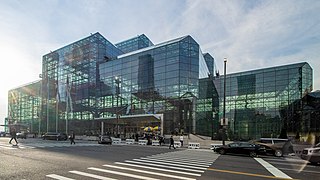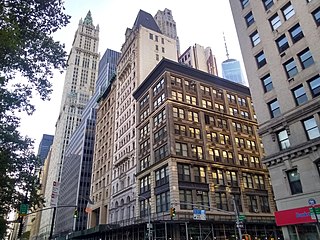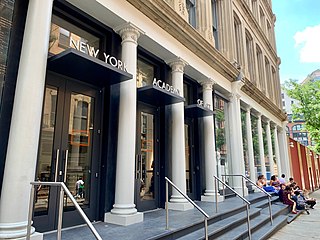
The Robert F. Kennedy Bridge is a complex of bridges and elevated expressway viaducts in New York City. The bridges link the boroughs of Manhattan, Queens, and the Bronx. The viaducts cross Randalls and Wards Islands, previously two islands and now joined by landfill.

Tribeca, originally written as TriBeCa, is a neighborhood in Lower Manhattan in New York City. Its name is a syllabic abbreviation of "Triangle Below Canal Street". The "triangle" is bounded by Canal Street, West Street, Broadway, and Chambers Street. By the 2010s, a common marketing tactic was to extend Tribeca's southern boundary to either Vesey or Murray Streets to increase the appeal of property listings.

The New York Botanical Garden (NYBG) is a botanical garden at Bronx Park in the Bronx, New York City. Established in 1891, it is located on a 250-acre (100 ha) site that contains a landscape with over one million living plants; the Enid A. Haupt Conservatory, a greenhouse containing several habitats; and the LuEsther T. Mertz Library, which contains one of the world's largest collections of botany-related texts. As of 2016, over a million people visit the New York Botanical Garden annually.

The Jacob K. Javits Convention Center, commonly known as the Javits Center, is a large convention center on Eleventh Avenue between 34th Street and 38th Street in Hell's Kitchen, Manhattan, New York City. It was designed by architect James Ingo Freed of Pei Cobb Freed & Partners. The space frame structure was constructed from 1979 to 1986 and was named to honor Jacob Javits, the United States Senator for New York. When the Javits Center opened, it replaced the New York Coliseum at Columbus Circle as the city's major convention facility; the Coliseum was subsequently demolished and replaced by Time Warner Center.
Viviana A. Rotman Zelizer is an Argentinian sociologist and the Lloyd Cotsen '50 Professor of Sociology at Princeton University. She is an economic sociologist who focuses on the attribution of cultural and moral meaning to the economy. A constant theme in her work is the economic valuation of the sacred, as found in such contexts as life insurance settlements and economic transactions between sexual intimates. In 2006, she was elected to the PEN American Center, and in 2007 she was elected to both the American Academy of Arts & Sciences and the American Philosophical Society.

Jonathan Mark Tisch is an American businessman. He is the CEO of American luxury hospitality company Loews Hotels. Tisch is also a board member of the Tribeca Film Institute.

The Civic Center is an area and neighborhood in Lower Manhattan, Manhattan, New York City, that encompasses New York City Hall, One Police Plaza, the courthouses in Foley Square, the Metropolitan Correctional Center, and the surrounding area. The district is bound on the west by Tribeca at Broadway, on the north by Chinatown at Worth Street or Bayard Street, on the east by the East River and the Brooklyn Bridge at South Street, and on the south by the Financial District at Ann Street.

Chambers Street is a two-way street in the New York City borough of Manhattan. It runs from River Terrace, Battery Park City in the west, past PS 234, The Borough of Manhattan Community College, and Stuyvesant High School, to the Manhattan Municipal Building at 1 Centre Street in the east. Between Broadway and Centre Street, Chambers Street forms the northern boundary of the grounds surrounding New York City Hall and the Tweed Courthouse. Opposite the Tweed Courthouse sits the Surrogate's Courthouse for Manhattan. 280 Broadway the Marble Palace, lies west of there, on the north side of Chambers.

Central Synagogue is a Reform Jewish congregation and synagogue at 652 Lexington Avenue, at the corner of 55th Street in the Midtown Manhattan neighborhood of New York City. The current congregation was formed in 1898 through the merger of two 19th-century synagogues: Shaar Hashomayim and Ahawath Chesed. The synagogue building was constructed from 1870 to 1872 for Ahawath Chesed. As of 2014, Angela Buchdahl is Central's senior rabbi.

60 Hudson Street, formerly known as the Western Union Building, is a 24-story telecommunications building in the Tribeca neighborhood of Manhattan in New York City. Built in 1928–1930, it was one of several Art Deco-style buildings designed by Ralph Thomas Walker of Voorhees, Gmelin and Walker for telecommunications in the early 20th century. 60 Hudson Street spans the entire block between Hudson Street, Thomas Street, Worth Street, and West Broadway.

108 Leonard, formerly known as 346 Broadway, the New York Life Insurance Company Building, and the Clock Tower Building, is a residential structure in the Tribeca neighborhood of Manhattan in New York City, United States. Built from 1894 to 1898, the building was constructed for the New York Life Insurance Company. Stephen Decatur Hatch created the original plans while McKim, Mead & White oversaw the building's completion. The building occupies a city block bounded by Broadway to the west, Leonard Street to the north, Lafayette Street to the east, and Catherine Lane to the south. It is a New York City designated landmark and is listed on the National Register of Historic Places.

49 Chambers, formerly known as the Emigrant Industrial Savings Bank Building and 51 Chambers Street, is a residential building at 49–51 Chambers Street in the Civic Center neighborhood of Manhattan in New York City. It was built between 1909 and 1912 and was designed by Raymond F. Almirall in the Beaux-Arts style. The building occupies a slightly irregular lot bounded by Chambers Street to the south, Elk Street to the east, and Reade Street to the north.

The Rogers Peet Building is an eight-story building in the Civic Center and Tribeca neighborhoods of Manhattan in New York City. Built between 1898 and 1899, it replaced a five-story structure that was home to the Rogers Peet clothing store between 1863 and 1898, when the original structure burned down.

The New York Academy of Art is a private art school in Tribeca, New York City. The academy offers a Master of Fine Arts degree with a focus on technical training and critical discourse as well as a Post-baccalaureate Certificate of Fine Art. The school annually hosts two public events: the TriBeCa Ball and the fund-raising auction Take Home a Nude, both known to attract high-profile guests.

The Perelman Performing Arts Center, branded as PAC NYC, is a multi-space performing arts center at the northeast corner of the World Trade Center complex in Manhattan, New York City. The Performing Arts Center is located at the intersection of Vesey, Fulton, and Greenwich Streets in Lower Manhattan. The building is named for billionaire Ronald Perelman, who donated $75 million to its construction.

287 Broadway is a residential building at the southwest corner of Broadway and Reade Street in the Civic Center and Tribeca neighborhoods of Lower Manhattan in New York City. The six-story, cast iron building was designed by John B. Snook in the French Second Empire and Italianate styles and was completed in 1872. Through the 19th and 20th centuries, it served as an office building before becoming a residential structure. 287 Broadway is a New York City designated landmark and is listed on the National Register of Historic Places.
Meg Jacobs is a historian of U.S. political history and political economy. She is a Senior Research Scholar at the Princeton School of Public and International Affairs and in the Department of History at Princeton University.

The Mutual Reserve Building, also known as the Langdon Building and 305 Broadway, is an office building at Broadway and Duane Street in the Tribeca neighborhood of Manhattan in New York City. The 13-story building, constructed between 1892 and 1894, was designed by William H. Hume and built by Richard Deeves, with Frederick H. Kindl as chief structural engineer. It is just east of the Civic Center of Manhattan, and carries the addresses 305–309 Broadway and 91–99 Duane Street.

Julian Emanuel Zelizer is a professor of political history and an author in the United States at Princeton University. Zelizer has authored or co-authored several books about American political history; his focuses of study are the second half of the 20th century and the 21st century.

The Concert Grove is a section of Prospect Park, Brooklyn, New York City, that historically functioned as an outdoor music venue. It still serves as a sculpture garden lined with busts of musical figures, largely put up by German American Sängerfest participants and other cultural groups. The Concert Grove also includes the Concert Grove Pavilion, formerly known as the Oriental Pavilion, and adjoins a Lincoln sculpture facing the lake.



















